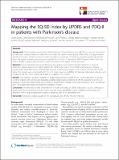| dc.contributor.author | Dams, Judith | |
| dc.contributor.author | Klotsche, Jens | |
| dc.contributor.author | Bornschein, Bernhard | |
| dc.contributor.author | Reese, Jens P | |
| dc.contributor.author | Balzer-Geldsetzer, Monika | |
| dc.contributor.author | Winter, Yaroslav | |
| dc.contributor.author | Schrag, Anette | |
| dc.contributor.author | Siderowf, Andrew | |
| dc.contributor.author | Oertel, Wolfgang H | |
| dc.contributor.author | Deuschl, Günther | |
| dc.contributor.author | Siebert, Uwe | |
| dc.contributor.author | Dodel, Richard | |
| dc.date.accessioned | 2014-02-21T20:31:20Z | |
| dc.date.issued | 2013 | |
| dc.identifier.citation | Dams, Judith, Jens Klotsche, Bernhard Bornschein, Jens P Reese, Monika Balzer-Geldsetzer, Yaroslav Winter, Anette Schrag, et al. 2013. Mapping the eq-5d index by updrs and pdq-8 in patients with parkinson’s disease. Health and Quality of Life Outcomes 11: 35. | en_US |
| dc.identifier.issn | 1477-7525 | en_US |
| dc.identifier.uri | http://nrs.harvard.edu/urn-3:HUL.InstRepos:11732111 | |
| dc.description.abstract | Background: Clinical studies employ the Unified Parkinson’s Disease Rating Scale (UPDRS) to measure the severity of Parkinson’s disease. Evaluations often fail to consider the health-related quality of life (HrQoL) or apply disease-specific instruments. Health-economic studies normally use estimates of utilities to calculate quality-adjusted life years. We aimed to develop an estimation algorithm for EuroQol- 5 dimensions (EQ-5D)-based utilities from the clinical UPDRS or disease-specific HrQoL data in the absence of original utilities estimates. Methods: Linear and fractional polynomial regression analyses were performed with data from a study of Parkinson’s disease patients (n=138) to predict the EQ-5D index values from UPDRS and Parkinson’s disease questionnaire eight dimensions (PDQ-8) data. German and European weights were used to calculate the EQ-5D index. The models were compared by R2, the root mean square error (RMS), the Bayesian information criterion, and Pregibon’s link test. Three independent data sets validated the models. Results: The regression analyses resulted in a single best prediction model (R2: 0.713 and 0.684, RMS: 0.139 and 13.78 for indices with German and European weights, respectively) consisting of UPDRS subscores II, III, IVa-c as predictors. When the PDQ-8 items were utilised as independent variables, the model resulted in an R2 of 0.60 and 0.67. The independent data confirmed the prediction models. Conclusion: The best results were obtained from a model consisting of UPDRS subscores II, III, IVa-c. Although a good model fit was observed, primary EQ-5D data are always preferable. Further validation of the prediction algorithm within large, independent studies is necessary prior to its generalised use. | en_US |
| dc.language.iso | en_US | en_US |
| dc.publisher | BioMed Central | en_US |
| dc.relation.isversionof | doi:10.1186/1477-7525-11-35 | en_US |
| dc.relation.hasversion | http://www.ncbi.nlm.nih.gov/pmc/articles/PMC3662160/pdf/ | en_US |
| dash.license | LAA | |
| dc.subject | Parkinson’s disease | en_US |
| dc.subject | Quality of life | en_US |
| dc.subject | EuroQoL/EQ-5D | en_US |
| dc.subject | UPDRS | en_US |
| dc.subject | PDQ-8 | en_US |
| dc.subject | Prediction | en_US |
| dc.title | Mapping the EQ-5D index by UPDRS and PDQ-8 in patients with Parkinson’s disease | en_US |
| dc.type | Journal Article | en_US |
| dc.description.version | Version of Record | en_US |
| dc.relation.journal | Health and Quality of Life Outcomes | en_US |
| dash.depositing.author | Siebert, Uwe | |
| dc.date.available | 2014-02-21T20:31:20Z | |
| dc.identifier.doi | 10.1186/1477-7525-11-35 | * |
| dash.authorsordered | false | |
| dash.contributor.affiliated | Siebert, Uwe | |


